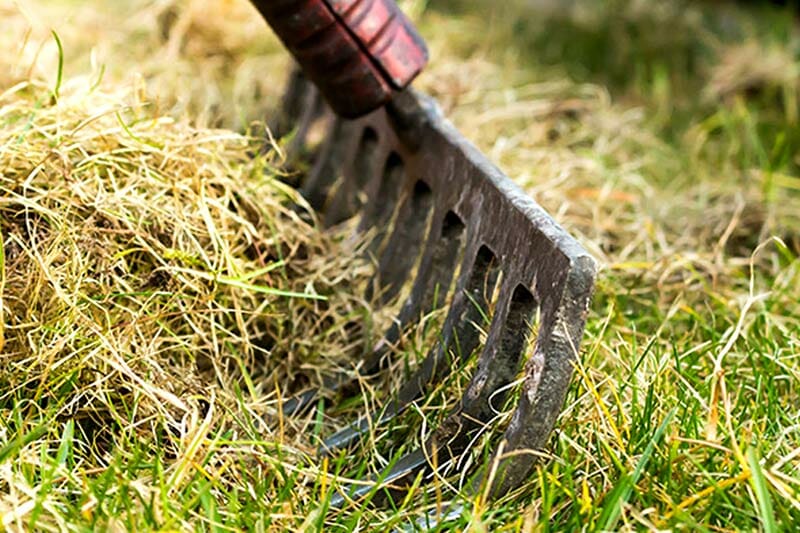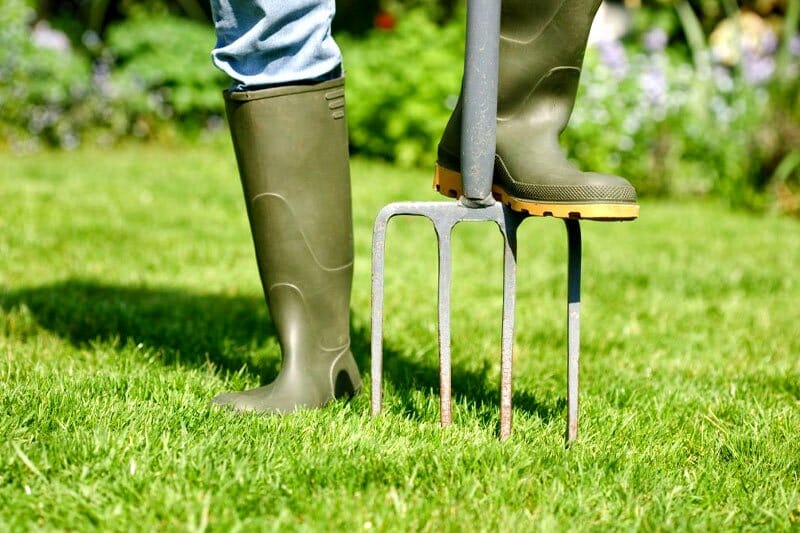The primary goal of both dethatching and aeration is alike, however, they tackle two different problems.
It is better to dethatch when a thick layer of thatch or dead grass builds up in your lawn. However, if your soil is too compact and hard to penetrate, it is best to aerate it.
The process of dethatching results in the removal of layers of dead grass or thatch, while the process of aerating results in breaking down tight soil for better fertilizer penetration. Therefore, what you choose depends on the specific soil need, even though both seem similar.

What is dethatching?
Dethatching is a process where you remove layers of thick thatch or dead matter from the top of the soil. First, you try breaking it up, especially if it is compact. Next, you remove it as well as possible without tearing up the grass. It is usually easier to remove broken-up thatch than to remove it while it is all stuffed together.
Thatch is made up of different types of natural matter from the soil, and it accumulates over time. Having a little thatch on the soil is not bad for its health, but it can quickly gather and form a semi-solid cover on the soil. When it happens, the soil cannot receive proper hydration and nutrients for productivity.

How to dethatch soil
Dethatching soil is usually easy if you have the right tools. A dethatching rake does the best job, and you can find one in a hardware or home improvement store. Such a rake is typically short-pronged and heavy, making it effective for digging into the soil and removing dead matter.
A power rake is also effective in dethatching the soil. It is ideal for soil without much thatch or for one that has thick grass that will not suffer under such a rake. A lawn may be able to withstand the rigors of a power rake.
In addition, consider using verticutters, which work on extremely thick thatch layers. They are also excellent on a lawn that is undergoing renovation.
Are there other benefits of dethatching the soil?
Apart from removing the layers of dead grass obstructing the soil, there are a few other benefits.
- The process beautifies the soil, especially if you use it on your lawn. Dead grass makes a yard look dirty and old, even though fresh grass may grow underneath it.
- It opens the soil up to much-needed sunlight. That way, plants can grow without obstruction.
- It promotes soil hydration and the penetration of air and nutrients, thereby making the soil healthier.
- Dethatching encourages the growth of roots and herbs.
- It also discourages standing water or water run-off.
What is aerating?
Aerating the soil means punching holes in it to allow nutrients, water, and air to penetrate the soil. It is ideal for hard soil because it is difficult for fertilizer to reach deep into it. The process encourages nutrients to get to the roots of plants and grass and improve overall health and growth.
There are special aeration tools, and if you have a hard time getting your lawn or garden to flourish due to hard soil, you may want to use them. Aeration may be hard, especially if you have never done it before and do not have the skills. In such a case, consider using professional services.

How to aerate soil
As mentioned before, aerating your soil may be an arduous task, and it is usually best to hire a professional to do the job. However, you can rent an aerator from a hardware store or local dealer and do the job if you can find online resources to guide you through the process. It may not be as daunting as it appears.
Are there benefits of aerating the soil?
Several benefits accrue to soil aeration. The soil is not the only beneficiary of the process.
- Aeration discourages water run-off and standing water, preventing waterlogging
- It encourages nutrient penetration into the soil for healthier and better results
- It reduces the compaction of the soil
- The roots of the grass are better able to spread and create stronger turf
- Thatch is less able to accumulate
What dethatching does to the soil
Dethatching removes old grass or thatch from the top of the soil. When this happens, the soil can better breathe and take in nutrients. Dead grass prevents sunlight, water, and other essential nutrients from penetrating the soil. Instead of becoming more nutritious to plants and herbs, the soil becomes sickly.
You can dethatch by manually pulling thatch up with your hand or using a rake. There are also a few other methods that help remove dead matter that suffuse and suffocate the soil. The method you use depends on your tools and where you are performing the task.
What aerating does to the soil
While the aeration process seems similar to that of dethatching, it works differently. Aerating puts holes in the soil to improve air, water, fertilizer, and nutrient penetration.
When soil is too tight or compacted, it is pretty difficult for it to receive all the nutrients it needs to flourish. By aerating it, you are making it possible to get all it needs to be productive.
There are different types of aerators for this purpose, such as aerating shoes, manual aerators, and engine-powered aerators. Typically, both processes produce the same results in the soil, but you must determine the soil’s immediate needs before deciding which approach is ideal.
Tips for dethatching
Knowing how to dethatch soil is one thing, but knowing how to make the most of it is entirely different. Below are some tips for dethatching your soil for the best results:
- Know the right time to dethatch. Every season is not the ideal time for it. Typically, the period between the end of winter and the beginning of spring works best because you can better assess how much thatch has accumulated.
- Apart from the time of the year, a visual inspection also helps determine whether or not the soil needs dethatching. If the soil is clearly visible through the grass, it may not be time to do it, even if you can see some thatch. However, if the soil looks suffocated or dense, and you cannot see the earth, dethatch it.
- A little thatch does the soil some good. Therefore, do not break out the rake every season or year when you see the smallest thatch. You may be damaging the soil instead of helping it. In other words, you may be uprooting the grass while thinking you are dethatching.
- Do not worry if the soil looks a little scarred after the process. After all, dethatching involves breaking tight thatch up and removing it. That may mean the dead grass is sticking to the soil and may need a little uprooting. If you do the job well, the long-term result will be worth it.
- Go in a vigorous manner while dethatching. Gently raking will not get the job done; you remove just a bit of thatch at most. You need to apply some force to break the thatch and remove it.
Tips for aerating
If you are to aerate your soil yourself, be it the lawn or garden, there are a few tips to make the process easier:
- Aeration works best for different seasons. If a plant or grass type grows primarily in cold weather, aerate the soil in early fall or spring. And if it is the type that works best in warm weather, aerate it in late spring.
- Do not wait to add fertilizer to the soil after aerating it. The point of breaking up the soil is to make it easier for nutrients and water to penetrate. If you give a break, fertilizer may not enter as well as it should. You will get the best results when newly aerated soil is fertilized.
- Aerate your soil every year or two times a year to maximize the results. It is possible to over-aerate soil, and it causes more harm than good. Punching too many holes too many times may weaken the soil.
- It works best when the soil is wet. If you try to aerate dry and compacted soil, you cannot get good results, and the tools may get damaged in the process. Even the most experienced professionals advise doing it after rain or if you water the ground.
- Ensure to make multiple passes since you are aerating yourself. It helps deliver adequate coverage of every part of the soil so that the process is effective.
Conclusion
Determining whether or not it is better to aerate or dethatch depends on the soil’s needs. Soil with too much thatch or dead grass needs dethatching, while hard soil needs aerating.
Both processes produce the same result of opening the soil to nutrients, water, and sunlight, but the methods differ. It also helps to follow the tips in this article, especially if you are doing the job yourself.






